|
Imitation, we are told, is the sincerest form of
flattery. And certainly, you wouldn't bother copying a flute that
you or your customers didn't admire. Siccama's flutes were copied
by probably more makers than any other kind, with the obvious and more
recent exception of Boehm's cylindrical flute. They were
obviously and deservedly popular.
It's worth remembering that British Patent Law offered patent
protection for only 14 years, so anyone could freely make a
Siccama-style flute after the patent ran out in 1859 or so.
As an aid to understanding the extent of Siccama's wider
contribution to the flute world, I've opened this presentation of
extant Siccama-style flutes by other makers. If you have or know
of a Siccama-style flute not listed here, do let us know!
Definitions
We'll use the same set of definitions we used in looking at Siccama's own flutes.
-
Siccama flute - one
where the third finger of each hand is extended by a key, permitting
the holes to be better placed and sized than on an 8-key flute.
A.K.A Siccama's Patent Diatonic Flute
-
Speaking length - the
distance form the centre of the embouchure to the end of the foot with
the slide fully compressed
-
Body & Foot length -
the distance from the top of the upper body tenon to the end of the
foot.
-
Brille - a device for
improving c# involving two ring keys and a covered key over a duplicate
c hole
-
Key Mounts - Block,
Post or Mixture
-
Key type - One
piece, "Hudson" type, Rod & axle, Additional
and Full.
Keys similar to those on 8-key flutes are noted as One-piece.
Hudson keys consist of a shaft and a cup which
screws into a hub on the far end. Some employed Rod
& axle style keys. Some later Siccama-based flutes had Additional
keywork (ie more holes were covered with keys than just L3 and R3), and
some (F) had keys on every hole.
-
Metal - Sterling
silver (tarnishes black) or Nickel Silver (tarnishes
green/yellow)
|
English makers
Siccama Flutes by Hudson
Looking for Siccama-style flutes by other makers, we should
first check out previous employees. Sure enough, we find a very
interesting flute by John Hudson, who had, as far as we can tell, been
Siccama's chief flute-maker before going out on his own in 1853.
The flute isn't marked Siccama, indeed it is marked:
R.S. PRATTEN'S PERFECTED
HUDSON
3 RATHBONE PLACE
OXFORD St
LONDON
121
(the serial number is not totally clear)
And indeed, it currently doesn't look like a
Siccama, having been reverted to a simple 8-key system, probably in the
late 20th century. But, under close inspection, it's easy to see
the plugged holes where once the two Siccama keys were mounted, and
where the two pads seated. You may be able to just make them out
as dark circular patches to the immediate right of the new holes 3 and
6 in the image below.

Siccama style flute by
Hudson, private collection, UK, image courtesy of owner.
Equally interesting, the flute was also fitted
with a thumb-operated normally-closed C-key, something mentioned in Pratten's Fingering Chart. This was also
relatively recently removed. You can see the short extension to
the left end of the c key where the thumb lever connected. The
arrangement is similar to the Chappell shown further down the page.
Now a convenient C key does make particular good
sense on a Siccama, where the usually deficient notes of the 8-key have
generally been dealt with, with the exception of c and c#. The
thumb key will give a perfect c, and with the thumb key opened, c# will
also be much cleaner and in good pitch.
Note too, the classic "Hudson keys" - where the
cup is a separate item which screws into a threaded boss at the end of
the shaft. Note also the unusual over-the-top style G# lever -
Siccama's flutes featured the typical English down-the-side G#
lever. Examination of the original hole spacing (including the
plugged holes) shows them to be virtually identical to the writers'
Siccama No 321.
So summarising the interesting points and
raising the obvious questions:
-
A Siccama flute, but marked Pratten's
Perfected. Siccama's patent had many years to run - how is this
possible?
-
By serial number 121, Hudson has dropped his
"Hudson from Siccama" identifier
-
Is this Hudson No 121, or Pratten No 121, or
both?
-
Put another way, were all Hudson's flutes
Pratten's Perfecteds?
-
The over-the-top G# lever. Why?
-
And the Thumb C lever, later offered as an
option on Pratten's Perfected flutes by Boosey & Co.
I am unaware of any previous reportage of Siccama
style flutes being offered by Hudson under the name Pratten's
Perfected. It illustrates that examining extant instruments is a
far more profitable line of research than relying on the incomplete and
sometimes thoroughly misleading period records.
Siccama Flutes by Boosey & Co
Our next port of call is Boosey & Co.
They hired Siccama's previous employee John Hudson, mentioned above, to
manage their flute building. They also acquired the rights to the
R.S. Pratten's Perfected range of flutes, which had been derived from
the Siccama by Pratten and Hudson, and which included Siccama-style
10-key flutes in the range.
Unfortunately, it's hard to decipher what
proportion of Boosey's flutes were Siccama-based, as the factory
records (which cover the period 1857 to 1930) are rather vague.
By far the majority of Boosey's output were military instruments,
particularly Bb fifes, and flutes and piccolos in the band keys (Bb,
Eb, F). This accounts for about 75% of the output!
The other major categories appear to be
cylindrical flutes (but with presumably old fingering), 151, and Boehm
system, 351. There is clear record of some 54 Siccamas, but many
more could be hiding among the 768 "concert flutes"
mentioned. For example, what is the "Pratten Cone"
illustrated below if it is not a Siccama?

Extent Boosey Siccama-style flutes include:
|
| Serial Number |
Speaking length |
Body & foot length |
Brille? |
Key Mounts? |
Key
type |
Metal |
Collection & Cat No |
| 13747 |
Head missing |
Est. 435 |
N |
P |
R |
|
Powerhouse Museum |
Siccama style flute from Butler
It's probably a bit cheeky calling George Butler an English
maker, as he appears to have started up in Dublin in 1826, then opened
a London branch in 1858.
Cylindrical (ie Boehm's bore with cylindrical body and
"parabolic" head) Siccama-style flute in Eb, at A452, obviously
intended for military band use. Note block mounting for some keys
and posts for others. The Short F and G# keys are mounted on the
same axles as the two Siccama keys but operate independently.
Marked "Butler Haymarket London and Dublin". There is no serial
number, but the Haymarket address puts it between 1865 and 1898.

Butler Eb Siccama style
flute, with kind permission of owner, player and teacher Frank
Claudy.
Image courtesy of David Migoya, Denver flute restorer and researcher.
Siccama Flutes by Chappell
Samuel Arthur Chappell, born London, 1834, died 1904,
advertised in the 1880's as, among other things, manufacturer of the
patent Siccama and Clinton flutes. Certainly Chappell Siccama
flutes seem relatively common. The company's address is a useful
indicator of dates:
1862: 214 Regent St
1866-70: 45 New Bond St
1871-1901: 52 New Bond St.

Siccama style flute, with
brille, by SA Chappell, Cocuswood, Nickel Silver
The flute is marked:
(crown)
SICCAMA
PATENTEE
1254
S.A. CHAPPELL
52 NEW BOND ST
LONDON
Note the mix of block mounting for most of the
regular keys and post mounting for the Siccama keys, brille, short F
and the c and F key guides. Note also the incised rings on the
barrel slide and the stopper rod to assist tuning to different pitches.
Here's an interesting addition - a thumb operated
C key. Note again the interesting mix of blocks and posts.
Essentially, whatever worked.

This one looks suspiciously like a Siccama by Siccama.
Complete with Brille and thumb keys for C and Bb, as well as a D trill
key, all done in Hudson-like keys.

So far, we have information on these
Siccama-style flutes by Chappell:
|
| Serial Number |
Speaking length |
Body & foot length |
Brille? |
Key Mounts? |
Key
type |
Metal |
Collection & Cat No |
| 150 |
|
|
|
|
|
S |
Sold |
| 1114 |
|
|
Y |
|
|
NS |
Adrian Duncan |
| 1183 |
568 |
422 |
Y |
P |
H |
S |
Rick Wilson |
| ? |
|
|
Y |
|
Mix |
|
? |
| 1198 |
|
|
Y |
P |
H |
S |
Ebay |
| 1254 |
574 |
423 |
Y |
Mix |
O |
NS |
Greg Lahey |
| 1429 |
571 |
424 |
Y |
Mix |
R |
NS |
Powerhouse |
| 1777 |
582 |
449 |
Y |
P |
Mix |
NS |
Edinburgh Uni (ex Sir Nicholas Shackleton) |
Siccama flutes by Henry Potter
This Siccama style flute by Henry Potter came up for sale recently ...

Note, the barrel liner seems to be missing, possibly locked onto the
protruding part of the head slide. Like the Chappel flute above,
it's a mix of block-mounting for the regular keys and post mounting for
the Siccama keys.
Siccama Flutes by Hawkes
Hawke's Siccama-style flutes look very similar to the Chappell
above, so let's take a close look at the more interesting bits:
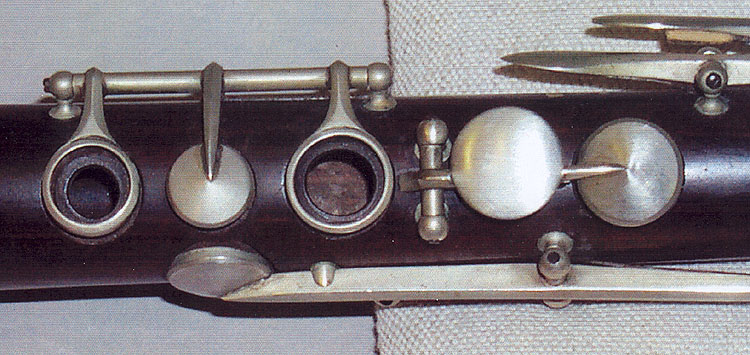
Detail of Hawkes flute,
Powerhouse Museum, Sydney Cat No H8964,
image kindly supplied by Curator, Michael Lea.
Again we see the Brille mechanism to improve venting of C#.
Extant Hawkes Siccamas include:
|
| Serial Number |
Speaking length |
Body & foot length |
Brille? |
Key Mounts? |
Key
type |
Metal |
Collection & Cat No |
| - |
|
427 |
Y |
P |
O |
NS |
Powerhouse |
| - |
575 (cyl) |
456 (cyl) |
N |
P |
R |
|
Helen Valenza |
| - |
578 |
433 |
N |
P |
O |
S |
Cady Stauss |
Siccama Flutes by Metzler
A nicely finished Siccama-style flute by London maker Metzler.
Note again the mix of block and post mounting. The cap is a modern
replacement in a different timber.
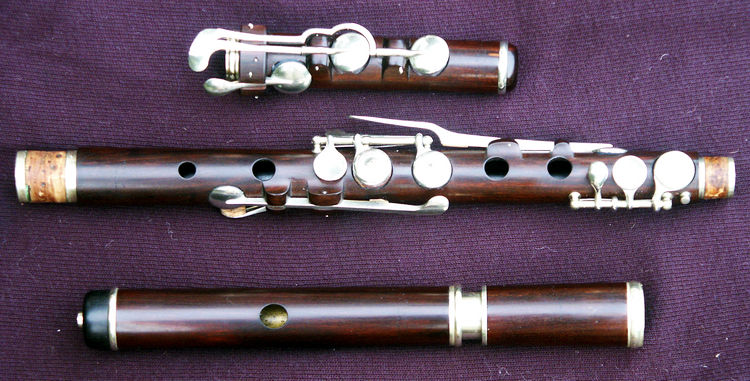
Thanks to Graeme Roxburgh, NZ collector, for this image.
And here's a fully-keyed Metzler Siccama, sold on Ebay...
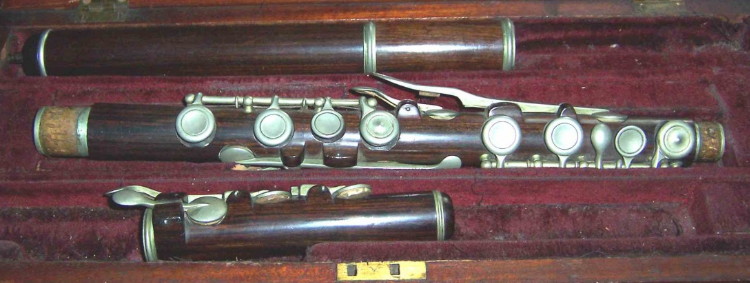 |
Rudall Carte & Co
Even the mighty Rudall Carte and Co made some Siccama style
flutes, and therein lies an interesting tale. Rockstro quotes
Carte delving into his diary: "On the second of June [1842] I find that
Siccama met Rudall & Rose at my house, and, after making the
necessary promise of secrecy, they were shown the model, and talked
over the matter, which ended in their not thinking it worth further
consideration. I was well pleased with the idea, but
plainly saw that the thing would not do as it was. Siccama urged
me to consider it well, and I took the flute with me to Newcastle, but
shortly afterwards returned it to him at his desire. So much for
the date of Siccama's first abortion."
Now we can't be sure that this was the flute in question, as
Siccama went on to patent a number of concepts. Given though that
Carte was "well pleased with the idea" it seems most likely to have
been this instrument, as the others were considerably less practical.
So, given Rudall & Rose's rejection of the instrument, and
Carte's rather cavalier dismissal, it's perhaps especially delicious to
find their company making a version (albeit cylindrical) some 58 years
later ....

Rudall Carte & Co No
7238, cylindrical, cocus wood & nickel silver (image courtesy Dan
Campbell).
Note that in addition to the usual Siccama keys,
it has two extra trill keys giving d and eb. Robert Bigio advises
that it was "made in 1900 ... by Chapman, who supplied flutes like this
[to Rudall Carte] in some bulk. I suspect he worked elsewhere [ie not
at Rudall Carte's], as his flutes are listed in batches with the same
description and date. The flute was bought by Whitehouse & Marlor".
Beare & Sons
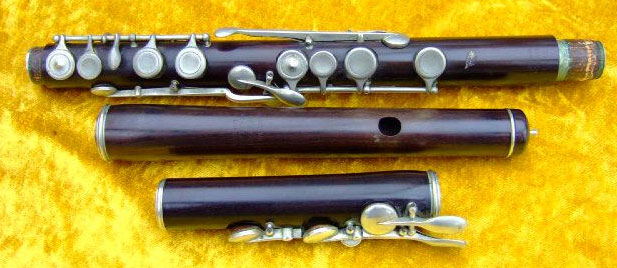
Another cylindrical flute, this one is marked
"Improved Siccama" and Beare & Sons. As they were listed as
importers dealers, probably another London maker actually carried out the
work. The description "Improved Siccama" smacks of Boosey & Co,
although the angled G# key is not normally an English feature.
|
Whitacker
C. Whitaker, who
flourished London circa 1890, is recorded by Langwill as a "specialist
in Siccama-model flutes". Interesting that he could specialise in
a flute that was being ridiculed in Rockstro's book released in that
same year!

The Whitaker Siccama-style flute pictured above came up for
sale on Ebay in March 2005.
And even good old Anon
Yes, even an unmarked Siccama style flute is reported by
English collector John Roe.
|
Continental makers
Siccama-style Flute by Ritterhausen
Seems the Berlin company of Ritterhausen also caught the
Siccama bug, but responded in a predictably German way. You'll
see in the flute below:
- the little knobs each side of the embouchure common on the
German Reform flute
- the lack of a separate tuning slide (who needs it when
pitch is stable?)
- the typically small holes of German style flutes
- all rod & axle construction
- the foot extending to low B
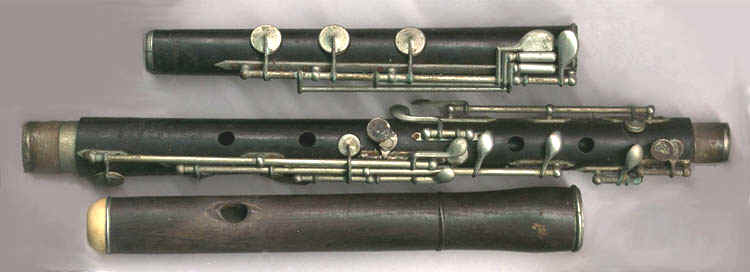
and if we look at the back (from L to R):

- trill key for e, operated by R1
- trill key for d, operated by R2
- the c key, operated from along the D trill rod by R1
- A Bb key (cup topside) operated by L thumb
- A second Bb key on the same axle, but operated by R1
- and the usual Short F.
Note that only a modest amount of hole relocation has been
looked for using the Siccama approach - no doubt just enough to achieve
the popular German goal of uniformity in hole size. Note also
just how much hardware is needed to achieve a fairly common German
flute configuration when you adopt rod & axle construction.
Now we can't be sure of course that this flute was inspired by
Siccama - Ritterhausen may well have come up with the idea himself or
from some other source. But it's certainly interesting that,
stripped of the obligatory German trill and alternate keys, it fits the
Siccama pattern exactly. So, in the least case, "great minds
think alike".
Finally, this flute was also badged "Carl Fisher, NY", showing
that a market existed for such instruments in the US, which we will see
reinforced below.
Djalma Julliot-Mignolet
This fascinating flute (and the notes below) comes to us from
the Dayton C. Miller Collection:

Flute in C, unsigned, according to DCM correspondence with
Jean Mignolet, Denver, Colorado, 31 Oct. 1920: "...it was made by my
friend Djalma Julliot, La Couture Boussey, France, who at the time made
flutes for Paul Taffanel."
Key Holes System: Cylindrical bore, old system, with
Mignolet patent G#, one piece body to D, this instrument is, in effect,
a metal version of the 10-keyed Siccama flute (minus long F,
low C#, C) with the exception that the left hand 3rd finger key closes
two large toneholes for G and the little finger then reopens the lower
of the two for G#, similar to the Dorus arrangement of dual opposing
springs. 7 keys, 4 uncovered fingerholes.
Julliot's decision to vent the G# when playing A would be a
very effective improvement.
The instrument can be examined in detail by entering DCM 0139
at the DCM search
site.
Other Continental Makers
The Belgian company of C. Mahillon made Siccama model flutes
and were reputed to have been the first to apply the Brille mechanism
to them. This was a good move, curing the only other dubious note
on the instrument. We'll bring you an image when
available.
In the meantime, this catalog extract reveals that we're
talking a pretty standard Siccama, but with Brille. The barrel (if
indeed it is a separate barrel and not a cosmetic one) has a more
continental look, but essentially it is a classic large-hole British
style instrument.

US Makers
Siccama's style of flute seemed to be very popular in the US
with a number of US makers supplying them. It's not always easy
to tell under these circumstances whether they were actually made in
the US or brought in and re-badged. We'll take the cautious
approach that they were made in the US until more evidence comes to
hand.
Pond
William Pond was the son of Sylvanus Billings Pond and it
seems, like his father, there is no evidence of him as a maker, but he
is known to be a dealer and music publisher. Looking at the image
below we see several points of similarity and difference to Siccama's
own product:
- The keys resemble Hudson's, but do not appear to have the
screwed-on cups
- The cap and foot termination is more Rudall than Siccama's
rounded style
- The top of the barrel has no ring - a common feature in
Germany and the US
- The m-shaped bends in the low C key

Image kindly provided by Rick Wilson,
mathematician, collector and player.
Cottier
Hugh Cottier certainly seems to have been a flute maker,
indeed he showed the Diatonic flute at several exhibitions.
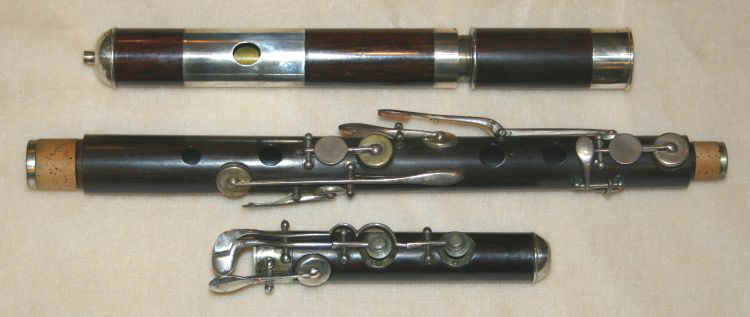
A quite similar flute to the Pond, especially in the key-work,
although the cap and foot end design is more "Siccama". Again,
thanks to Rick Wilson
for providing this image.
William Hall & Son
Alan Maslac sends us this image of a Siccama flute
stamped William Hall & Son, with their 239 Broadway, NY address and
Siccama's descriptor "Diatonic", but no mention of the man himself or
his patent (which would probably not have applied in the US at that
time). Alan reports: "The instrument is in flawless condition and
the keywork is sterling silver. It is the most powerful flute (other
than the modern Boehm) that I have ever played, with good intonation
throughout. 440Hz requires the headjoint pulled out about half an
inch."
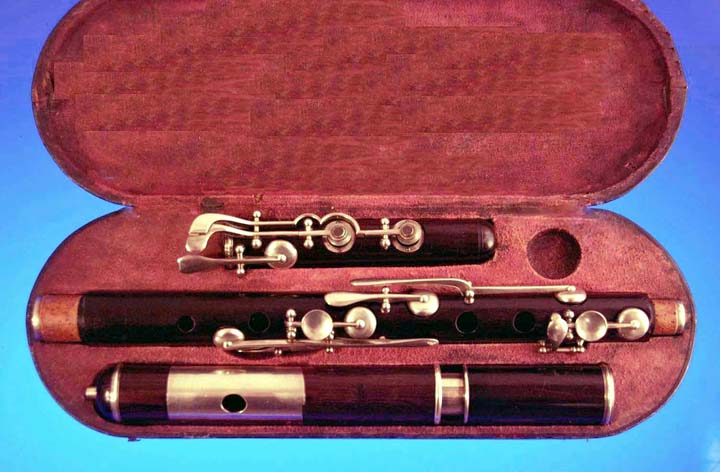
Clearly the flute has a lot in common with Siccama's own instruments,
but perhaps even more in common with the flutes by other US makers
immediately above this one. Of particular interest is the fact
that the keys look similar to the "Hudson" keys on Siccama's flutes, but
the keycups are integral and not screwed on to the shafts as the Hudson
keys are.
As I have observed elsewhere, we need a lot more work done on US
makers in the 19th century.
And, Monzani? But surely he's dead!
So what's this, lurking in the Dayton C Miller
Collection. It's clearly a Siccama, but it's stamped Monzani
& Co. Now Siccama patented his flute in 1845, and the old
English firm of Monzani & Co is only listed to about 1829.
Indeed, Tebaldo Monzani died in Kent in 1839. But, there's an
American Monzani as well, quite probably the son of the "English"
Monzani (who was actually from Verona anyway!). So this has to be
the American Monzani, Theobald.

Siccama style flute by
Monzani, DCM 0084.
Conclusions
It's easy to see from the above that Siccama's flutes were not
just something Siccama thought were good, but there was enough demand
that many other makers continued to make them long after his death and
in other countries. What greater tribute?
We'll be bringing you images and details of other flutes made
by and influenced by Siccama as they come to hand.
Back to McGee Flutes home
page
Created: 6 November 2003
|
|